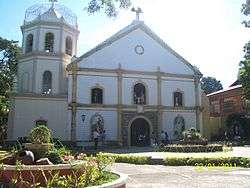San Juan, Ilocos Sur
| San Juan | ||
|---|---|---|
| Municipality | ||
| Municipality of San Juan | ||
 | ||
| ||
| Nickname(s): Buri Capital of the Philippines | ||
 Map of Ilocos Sur with San Juan highlighted | ||
.svg.png) San Juan Location within the Philippines | ||
| Coordinates: 17°43′45″N 120°27′39″E / 17.7292°N 120.4608°ECoordinates: 17°43′45″N 120°27′39″E / 17.7292°N 120.4608°E | ||
| Country |
| |
| Region | Ilocos Region (Region I) | |
| Province | Ilocos Sur | |
| District | 1st District | |
| Barangays | 32 (see Barangays) | |
| Government [1] | ||
| • Type | Sangguniang Bayan | |
| • Mayor | Benjamin Viloria Sarmiento | |
| • Electorate | 15,986 voters (2016) | |
| Area [2] | ||
| • Total | 64.37 km2 (24.85 sq mi) | |
| Population (2015 census)[3] | ||
| • Total | 26,411 | |
| • Density | 410/km2 (1,100/sq mi) | |
| Time zone | UTC+8 (PST) | |
| ZIP code | 2731 | |
| PSGC | 012920000 | |
| IDD : area code | +63 (0)77 | |
| Climate type | Tropical monsoon climate | |
| Income class | 3rd municipal income class | |
| Revenue (₱) | 343,214,904.27 (2016) | |
| Native languages |
Ilocano Tagalog | |
San Juan, formerly Lapog and officially the Municipality of San Juan, is a 3rd class municipality in the province of Ilocos Sur, Philippines. According to the 2015 census, it has a population of 26,411 people.[3]
Because it produces most of the goods made of buri leaf in the province, it is sometimes called the Buri Capital of Ilocos Sur.
San Juan is 426 kilometres (265 mi) from Metro Manila and 21 kilometres (13 mi) from Vigan City, the provincial capital.
History
The town of Lapog was established in 1772.
The name of the municipality has gone through a series of changes. The early settlers and occupants called it "Lapo", short for "Lapo-Lapo", a tall grass which grew everywhere in the area. In the year 1772, Don Tomas Aquino, the first local leader, initiated the organization of the scattered communities into one, calling the place "Lapog", a derivative of local vernacular "Lap-Lapog" which means unirrigated land. For 189 years, "Lapog" remained in the records as the official name of the town until June 18, 1961, Republic Act No. 3386 was enacted and it was renamed to San Juan. Since most of the inhabitants were of the belief that religious names bring peace, happiness, and prosperity, the town was renamed "San Juan", after the name of its patron saint, Saint John the Baptist.
It was stricken by all sorts of plagues and epidemics (like the smallpox epidemics of 1808 and 1918–19, locust infestation in 1903, and destruction of ricefields by worms called "arabas" in 1905). Bessang Pass, just south of the poblacion, was constructed in 1874. Americans destroyed their town hall in 1903. But despite these misfortunes, San Juan progressed into a prosperous community.
Barangays
San Juan is politically subdivided into 32 barangays. [2]
- Asilang
- Bacsil
- Baliw
- Bannuar (Poblacion)
- Barbar
- Cabanglotan
- Cacandongan
- Camanggaan
- Camindoroan
- Caronoan
- Darao
- Dardarat
- Guimod Norte
- Guimod Sur
- Immayos Norte
- Immayos Sur
- Labnig
- Lapting
- Lira (Poblacion)
- Malamin
- Muraya
- Nagsabaran
- Nagsupotan
- Pandayan (Poblacion)
- Refaro
- Resurreccion (Poblacion)
- Sabangan
- San Isidro
- Saoang
- Solotsolot
- Sunggiam
- Surngit
Demographics
| Population census of San Juan | ||
|---|---|---|
| Year | Pop. | ±% p.a. |
| 1903 | 7,035 | — |
| 1918 | 9,791 | +2.23% |
| 1939 | 10,674 | +0.41% |
| 1948 | 9,777 | −0.97% |
| 1960 | 12,654 | +2.17% |
| 1970 | 14,987 | +1.70% |
| 1975 | 16,329 | +1.73% |
| 1980 | 17,443 | +1.33% |
| 1990 | 20,328 | +1.54% |
| 1995 | 21,222 | +0.81% |
| 2000 | 23,146 | +1.88% |
| 2007 | 23,808 | +0.39% |
| 2010 | 25,199 | +2.09% |
| 2015 | 26,411 | +0.90% |
| Source: Philippine Statistics Authority[3][4][5][6] | ||
In the 2015 census, the population of San Juan, Ilocos Sur, was 26,411 people,[3] with a density of 410 inhabitants per square kilometre or 1,100 inhabitants per square mile.
See also
References
- ↑ "Municipality". Quezon City, Philippines: Department of the Interior and Local Government. Retrieved 31 May 2013.
- 1 2 "Province: Ilocos Sur". PSGC Interactive. Quezon City, Philippines: Philippine Statistics Authority. Retrieved 12 November 2016.
- 1 2 3 4 Census of Population (2015). "Region I (Ilocos Region)". Total Population by Province, City, Municipality and Barangay. PSA. Retrieved 20 June 2016.
- ↑ Census of Population and Housing (2010). "Region I (Ilocos Region)". Total Population by Province, City, Municipality and Barangay. NSO. Retrieved 29 June 2016.
- ↑ Censuses of Population (1903–2007). "Region I (Ilocos Region)". Table 1. Population Enumerated in Various Censuses by Province/Highly Urbanized City: 1903 to 2007. NSO.
- ↑ "Province of Ilocos Sur". Municipality Population Data. Local Water Utilities Administration Research Division. Retrieved 17 December 2016.
